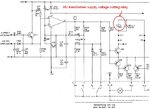agoo
Member level 3

After separating two sections for diag. purpose and changing everything back to normal I have lost HV even without load. No HV at all now. I checked every connection again and they are all OK. I don't know this is good or bad but I think is better condition than before.
Measured supply voltage of HV transformer is about 90V (point "G"). There is no scillation at point "R" and "H". Only DC voltage. No voltage at point "P" (about few mV) which shows no feedback. At normal operation point "P" should have 10V.
I have about 1 V at point 16 which goes to CR30 and CR31 for turning them on to start oscillation. Also replaced Q12 and Q13 with new ones with about 0.6V in their bases both when I turn the unit on but still no oscillation?
Agoo
Measured supply voltage of HV transformer is about 90V (point "G"). There is no scillation at point "R" and "H". Only DC voltage. No voltage at point "P" (about few mV) which shows no feedback. At normal operation point "P" should have 10V.
I have about 1 V at point 16 which goes to CR30 and CR31 for turning them on to start oscillation. Also replaced Q12 and Q13 with new ones with about 0.6V in their bases both when I turn the unit on but still no oscillation?
Agoo
Last edited:






